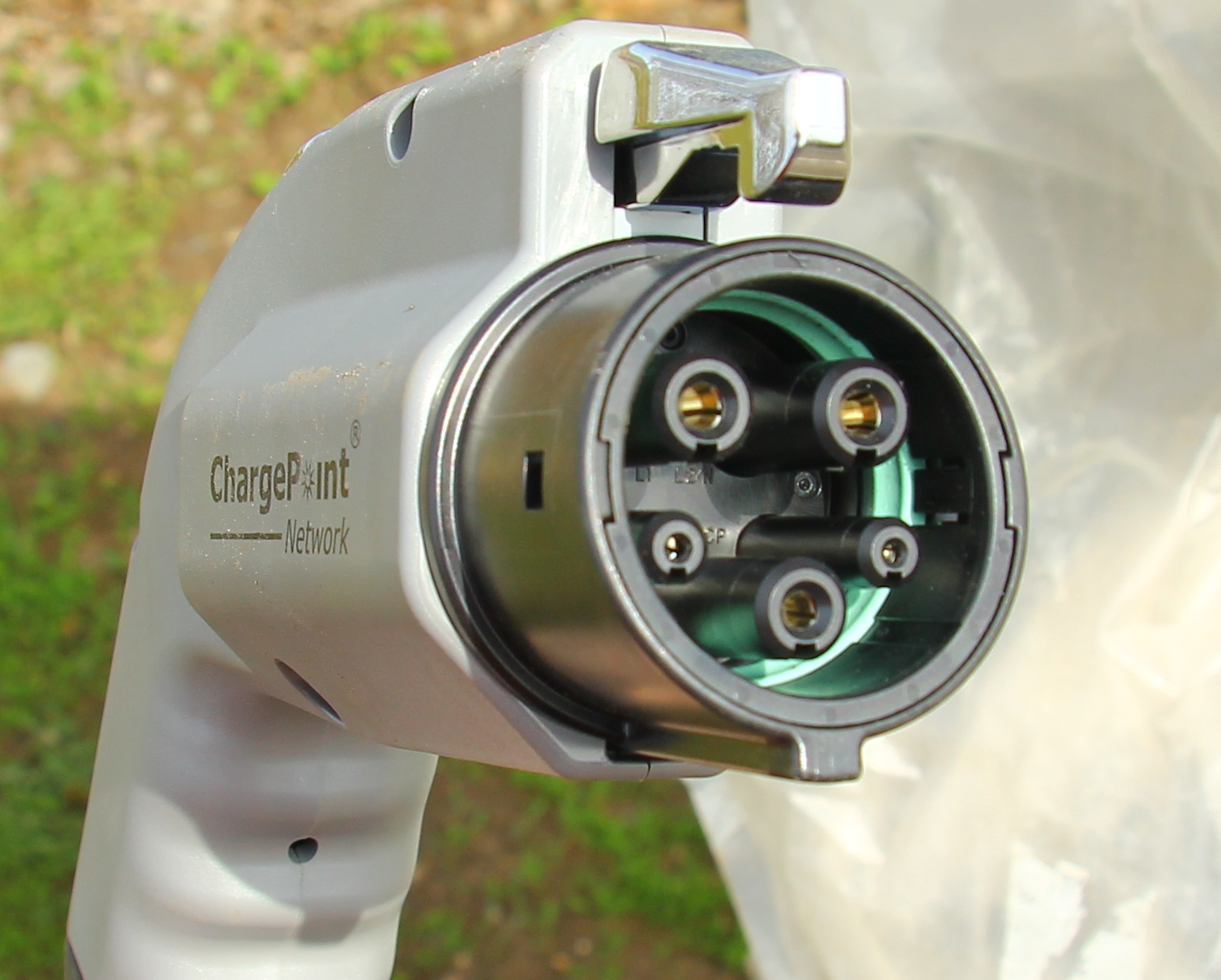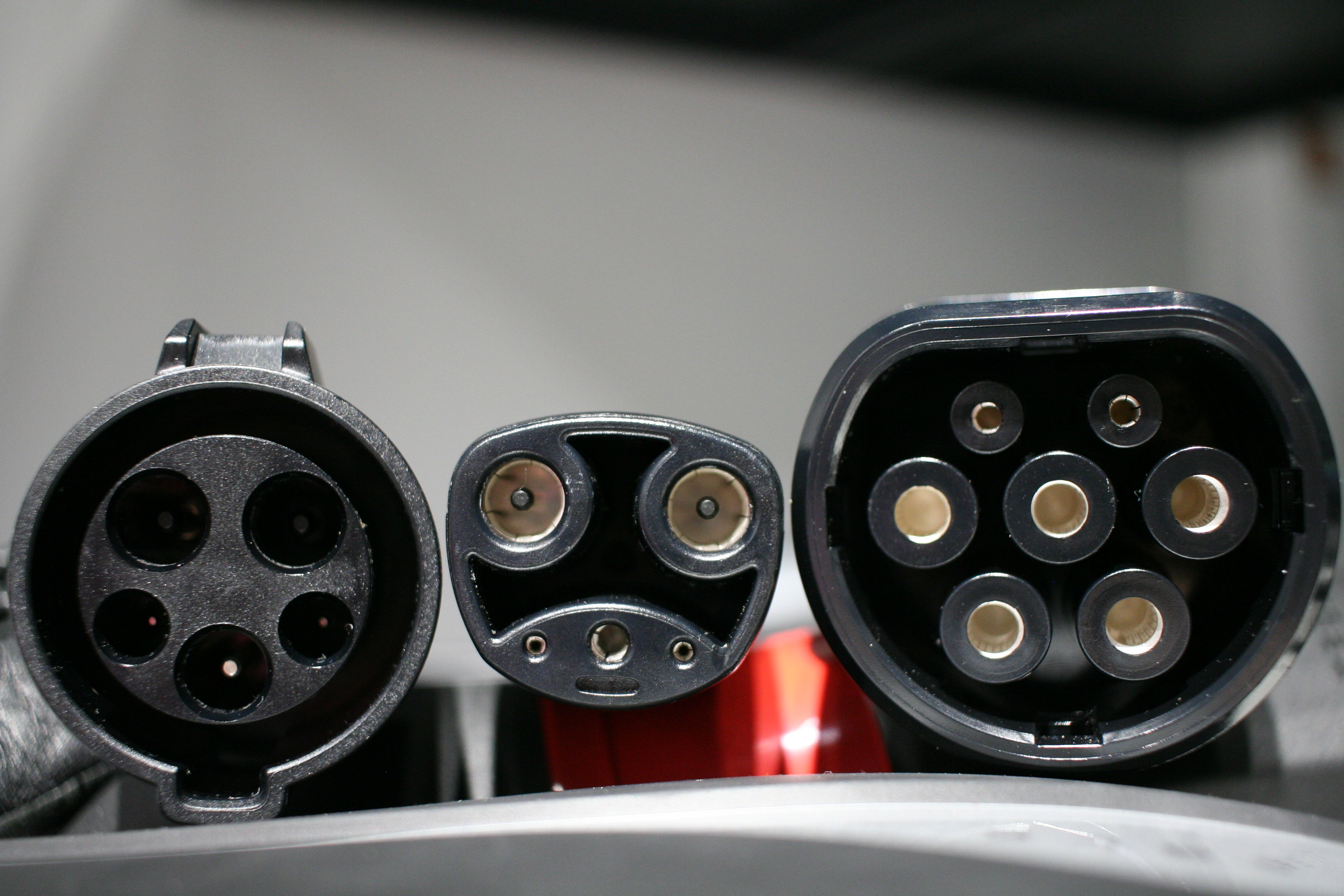|
SAE J3068
SAE J3068 "Electric Vehicle Power Transfer System Using a Three-Phase Capable Coupler" is a North American recommended practice published and maintained by SAE International. J3068 defines electrical connectors and a control protocol for electric vehicles. It has the formal title "SAE Surface Vehicle Recommended Practice J3068". J3068 defines a system of conductive power transfer to an electric vehicle using a coupler capable of transferring single-phase and three-phase AC power as well as DC power, and defines a digital communication system for control. J3068 also specifies requirements for the vehicle inlet, supply equipment connector, mating housings and contacts. History Initial discussions in the Electric Power Research Institute's Infrastructure Working Council meetings regarding issues related to three-phase charging in North America led to the development of J3068. There was a lack of non-proprietary, UL listed equipment that could be legally used in the Unite ... [...More Info...] [...Related Items...] OR: [Wikipedia] [Google] [Baidu] |
SAE J1772
SAE J1772, also known as a J plug or Type 1 connector after its international standard, IEC 62196 Type 1, is a North American standard for electrical connectors for electric car, electric vehicles maintained by SAE International under the formal title "SAE Surface Vehicle Recommended Practice J1772, SAE Electric Vehicle Conductive Charge Coupler". The SAE maintains the general physical, electrical, communication protocol, and performance requirements for the electric vehicle conductive charge system and coupler. The intent is to define a common electric vehicle conductive charging system architecture including operational requirements and the functional and dimensional requirements for the vehicle inlet and mating connector. The J1772 5-pin standard supports a wide range of Single-phase electric power, single-phase (1φ) alternating current (AC) charging rates. They range from portable devices that can connect to a household NEMA 5, NEMA 5-15 outlet that can deliver 1.44 kW ... [...More Info...] [...Related Items...] OR: [Wikipedia] [Google] [Baidu] |
Local Interconnect Network
LIN is a network protocol used for communication between components in modern vehicles. It is a low-cost single-step serial protocol that supports communications up to 19.2 Kbit/s with a maximum bus length of . History The need for a cheap serial network arose as the technologies and the facilities implemented in the car grew, while the CAN bus was too expensive to implement for every component in the car. European car manufacturers started using different serial communication technologies, which led to compatibility problems. In the late 1990s, the LIN Consortium was founded by five automakers (BMW, Volkswagen Group, Audi, Volvo Cars, Mercedes-Benz), with the technologies supplied (networking and hardware expertise) from Volcano Automotive Group and Motorola. The first fully implemented version of the new LIN specification (LIN version 1.3) was published in November 2002. In September 2003, version 2.0 was introduced to expand capabilities and make provisions for additional ... [...More Info...] [...Related Items...] OR: [Wikipedia] [Google] [Baidu] |
Type 2 Connector
The IEC 62196-2 Type 2 connector (sometimes referred to as Mennekes for the German company that designed it) is used for charging electric vehicles using AC power, mainly within Europe, Australia, NZ and many other countries outside of North America. The Type 2 connector was adopted as the EU standard in 2013, with full compliance required by 2025. The connector was chosen by the EU to promote electric mobility and ensure interoperability between different vehicles and charging stations. The Type 2 connector is equipped with seven pin connectors, which are used for communication between the vehicle and charger using the J1772 signaling protocol, and for either single or 3-phase AC power with a maximum voltage of 500 V, thereby delivering up to 43kW of power. A later, modified version of the Type 2 connector which includes two additional DC current pins at the base to allow for high-power (up to 350kW) DC fast charging, is known as a Combined Charging System (CCS) Combo 2 plug, ... [...More Info...] [...Related Items...] OR: [Wikipedia] [Google] [Baidu] |
Electric Vehicle Technologies
Electricity is the set of physical phenomena associated with the presence and motion of matter possessing an electric charge. Electricity is related to magnetism, both being part of the phenomenon of electromagnetism, as described by Maxwell's equations. Common phenomena are related to electricity, including lightning, static electricity, electric heating, electric discharges and many others. The presence of either a positive or negative electric charge produces an electric field. The motion of electric charges is an electric current and produces a magnetic field. In most applications, Coulomb's law determines the force acting on an electric charge. Electric potential is the work done to move an electric charge from one point to another within an electric field, typically measured in volts. Electricity plays a central role in many modern technologies, serving in electric power where electric current is used to energise equipment, and in electronics dealing with electrical c ... [...More Info...] [...Related Items...] OR: [Wikipedia] [Google] [Baidu] |
SAE J3068 Ed2 Pilot
SAE or Sae may refer to: Science, technology, and medicine : * Selective area epitaxy, local growth of epitaxial layer through a patterned dielectric mask deposited on a semiconductor substrate * Sepsis-associated encephalopathy, neurological complications of sepsis * Serious adverse event, in a clinical trial * Simultaneous Authentication of Equals, a password authentication protocol in computer networking * Sparse autoencoder, a class of text encoders in machine learning * Subcortical arteriosclerotic encephalopathy, a disease * Sum of absolute errors, in mathematics * Supervised agricultural experience * System Architecture Evolution, the core network architecture of 3GPP's LTE wireless communication standard Units and standards Units named after the Society of Automotive Engineers (see below): * SAE, several units of measurement of power; See Horsepower * SAE viscosity number, of motor oils * SAE steel grades * SAE fastener * SAE thread * United States customary units, e. ... [...More Info...] [...Related Items...] OR: [Wikipedia] [Google] [Baidu] |
International Electrotechnical Commission
The International Electrotechnical Commission (IEC; ) is an international standards organization that prepares and publishes international standards for all electrical, electronics, electronic and related technologies. IEC standards cover a vast range of technologies from power generation, transmission and distribution to home appliances and office equipment, semiconductors, fibre optics, batteries, solar energy, nanotechnology, and marine energy, as well as many others. The IEC also manages four global conformity assessment systems that certify whether equipment, system or components conform to its international standards. All electrotechnologies are covered by IEC Standards, including energy production and distribution, electronics, magnetics and electromagnetics, electroacoustics, multimedia, telecommunications and medical technology, as well as associated general disciplines such as terminology and symbols, electromagnetic compatibility, measurement and performance, dependa ... [...More Info...] [...Related Items...] OR: [Wikipedia] [Google] [Baidu] |
IEC 62196
IEC 62196 ''Plugs, socket-outlets, vehicle connectors and vehicle inlets – Conductive charging of electric vehicles'' is a series of international standards that define requirements and tests for plugs, socket-outlets, vehicle connectors and vehicle inlets for conductive charging of electric vehicles and is maintained by the technical subcommittee SC 23H “Plugs, Socket-outlets and Couplers for industrial and similar applications, and for Electric Vehicles” of the International Electrotechnical Commission (IEC). Plugs, socket-outlets, vehicle connectors and vehicle inlets according to this series of standards are used in EV supply equipment according to IEC 61851 series or IEC 62752 and in electric vehicles according to ISO 17409 or ISO 18246. Most plugs, socket-outlets, vehicle connectors and vehicle inlets according to this series of standards provide additional contacts that support specific functions that are relevant for charging of electric vehicles, e.g. power is not ... [...More Info...] [...Related Items...] OR: [Wikipedia] [Google] [Baidu] |
Socket Type-2
Socket may refer to: Mechanics * Socket wrench, a type of wrench that uses separate, removable sockets to fit different sizes of nuts and bolts * Socket head screw, a screw (or bolt) with a cylindrical head containing a socket into which the hexagonal ends of an Allen wrench will fit * Socket termination, a termination used at the ends of wire rope * Socket, the receptacle into which a tapered tool is inserted * Socket, an opening in any fitting that matches the outside diameter of a pipe or tube Biology * Eye socket, a region in the skull where the eyes are positioned * Tooth socket, a cavity containing a tooth, in those bones that bear teeth * Dry socket, an opening as a result of the blood not clotting after a tooth is pulled * Ball and socket joint Computing * Network socket, an end-point in a communication across a network or the Internet * Unix domain socket, an end-point in local inter-process communication * socket(), a system call defined by the Berkeley sockets API * CP ... [...More Info...] [...Related Items...] OR: [Wikipedia] [Google] [Baidu] |
EVSE
A charging station, also known as a charge point, chargepoint, or electric vehicle supply equipment (EVSE), is a power supply device that supplies electrical power for recharging plug-in electric vehicles (including battery electric vehicles, electric trucks, electric buses, neighborhood electric vehicles, and plug-in hybrid vehicles). There are two main types of EV chargers: Alternating current (AC) charging stations and direct current (DC) charging stations. Electric vehicle batteries can only be charged by direct current electricity, while most mains electricity is delivered from the power grid as alternating current. For this reason, most electric vehicles have a built-in AC-to-DC converter commonly known as the "onboard charger" (OBC). At an AC charging station, AC power from the grid is supplied to this onboard charger, which converts it into DC power to recharge the battery. DC chargers provide higher power charging (which requires much larger AC-to-DC converters) b ... [...More Info...] [...Related Items...] OR: [Wikipedia] [Google] [Baidu] |
Volvo Trucks
Volvo Trucks () is a truck manufacturing division of Volvo based in Gothenburg, Sweden. Volvo Trucks was a separate company within Volvo. The Volvo Group was reorganised on 1 January 2012 and as a part of the process, Volvo Trucks ceased to be a separate company and was instead incorporated into Volvo Group Trucks along Volvo's other truck operations, as Renault Trucks and Mack Trucks.Volvo Group reorganizes global truck business FleetOwner, 4 October 2011. Retrieved 19 November 2022. The first Volvo truck rolled off the production lines in 1928, and in 2016 Volvo Trucks employed more than 52,000 people around the world. With global headquarters in Gothenburg, Sweden, Volvo manufactures and assembles its trucks in eight wholly owned assembly plants and nine factories owne ... [...More Info...] [...Related Items...] OR: [Wikipedia] [Google] [Baidu] |




